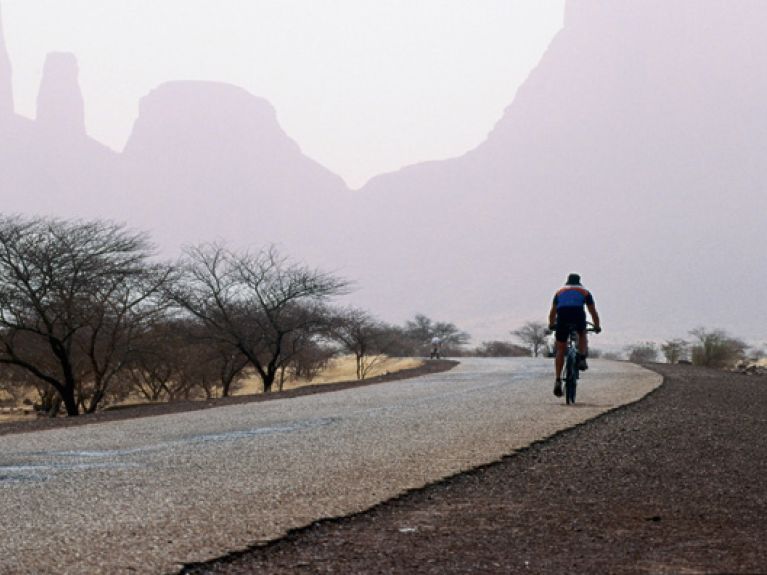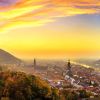9,000 kilometre-long „Iron Curtain Trail“
The Wolfsburger Joachim Franz and his expedition by e-bike along the former Iron Curtain – crossing 18 countries in 30 days

To move the world, we need to move ourselves – that’s the motto of Wolfsburg expedition athlete Joachim Franz. And he knows what he’s talking about. Since 2001, Franz has completed eight major expeditions – to raise awareness of the issue of HIV/AIDS. In recognition of this commitment, he was awarded the Order of Merit of the Federal Republic of Germany. Now the 54-year-old has taken to the road again, but this time on a different mission: his EExpedition Iron Curtain Trail, launched 25 years after the fall of the Iron Curtain, is designed to focus attention on the prospects of future mobility. Over the course of a month, Joachim Franz and e-bike expert Christian Roth cycled across Europe, travelling the entire length of the former partition line on two electric bikes. “Just as the fall of the Iron Curtain brought a change in thinking in Europe because it suddenly opened up completely new prospects, the advent of electromobility also requires a change in thinking,” is how Franz explains the basic idea behind his expedition. “I hope that it helps get as many people as possible interested in electromobility and all the potential it offers.”
On 27 June, exactly 25 years to the day after the symbolic cutting open of the border fence by the then foreign ministers of Austria and Hungary, the starting signal for the expedition was given in the far north, in Jakobselv on the border between Norway and Russia. The expedition ended four weeks later at the Bulgarian-Turkish border on the Black Sea, after covering nearly 9,000 kilometres, in daily legs of up to 350 kilometres, and crossing 16 other countries: Finland, Estonia, Latvia, Lithuania, Poland, Germany, the Czech Republic, Austria, Slovakia, Hungary, Slovenia, Croatia, Serbia, Romania, Macedonia and Greece. No easy task, even with the help of an electric motor.
Even before it started, the EExpedition was given recognition at the highest political level: the European Parliament assumed patronage of the project because it set out to “raise awareness of Europe’s history and at the same time promote dialogue on new, sustainable mobility”. The expedition was also supported by the State of Lower Saxony, the City of Wolfsburg, the company Wolfsburg AG and the Volkswagen Group – no coincidence given the fact that the region around Wolfsburg was for decades shaped by its proximity to the inner-German border and witnessed the fall of the Iron Curtain first-hand. It is also home to Germany’s largest car manufacturer, which, incidentally, has set its sights on becoming a leader in the development of electric vehicles.
Joachim Franz is a child of this region, too. He was born on 11 November 1960 in Volkswagen city Wolfsburg – a fact that seems to have preordained his future. His grandfather worked at Volkswagen, as did his father, and then Joachim himself. After completing secondary school, he began an apprenticeship as toolmaker at the Volkwagen plant, then spent year after year at the workbench. Until the summer of 1989, when – shortly before the fall of the Berlin Wall – he changed his life radically. Exactly why, he doesn’t really know himself: “All I realised was that I didn’t want to spend the rest of my days living a life like that. I wanted to try something new, to get moving.” To begin with, he spent a week cycling across Bavaria. Then he starts training, ran his first marathon and took up ultrarunning. He set world records, made it into the Guinness Book of Records, crossed the Ural Mountains on a kick scooter in 1996 and, finally, began taking part in extreme sports competitions.
Sport took him all over the world. But whether in South Africa, Nepal or the Philippines – wherever he went he encountered the effects of the HIV/AIDS pandemic, saw orphanages and hospices. He couldn’t shut his eyes to all this; he wanted to do something, to fight against people’s tendency to look the other way and forget. And he found a way, his way – and that was how the idea for the World Aids Awareness Expedition was born. A list of the expeditions reads like an excerpt from an adventure and extreme sports catalogue. In 2001/2002, Paris to Dakar on a mountain bike – solo. In 2003, a 2,500-kilometre trek across South Africa – a combination of marathon and bike race. In 2004, ascent of the 7,439-metre-high Pik Pobedy on the border between Kyrgyzstan and China. In 2005, the record tour from Alaska to Tierra del Fuego with five other racing cyclists – 23,000 kilometres non-stop, switching riders regularly relay-style. In 2006, ascent of the Aconcagua – at nearly 7,000 metres, the highest mountain in North and South America. In 2007, Franz completed a 4,000-kilometre-long AIDS “bow” across Germany by racing bike.
A year later, there followed the ascent of 19 summits between North Cape and Cape Town – a nearly two-month-long tour, constantly alternating between road and mountain. Finally, in 2011, his biggest achievement so far: travelling in five all-terrain pickups, Joachim Franz and his team draw a huge “W” on the world map, crossing 55 countries on all five continents in a 111-day marathon. All the expeditions included encounters, press conferences and round-table talks in the various countries. And this time was no exception. “I want to get things moving,” says Franz, who now runs an agency for team-building and personal development, “to set in motion a process of rethinking about the future of mobility.” ▪

